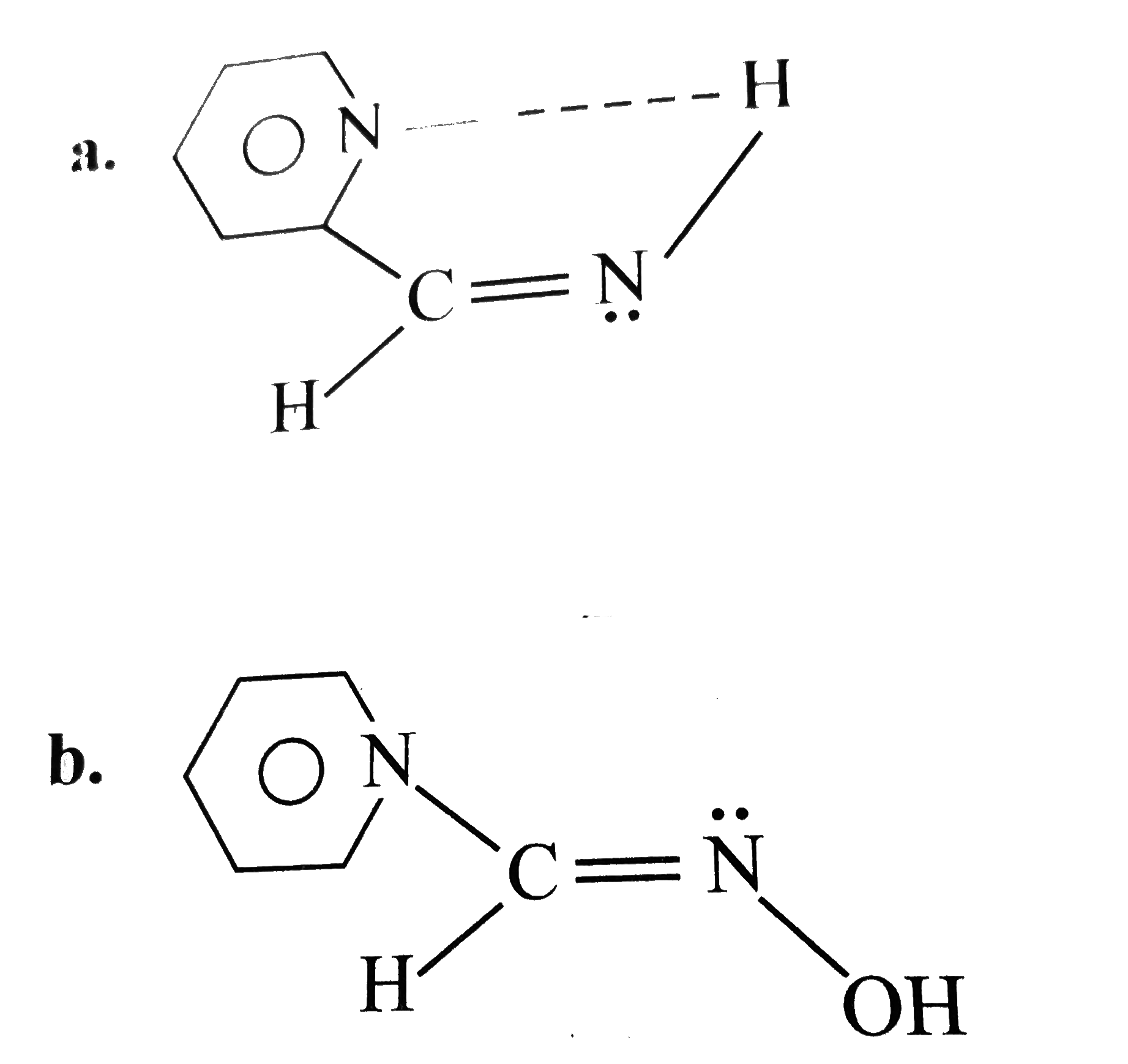The HFΘ2 ion solid state and in liquid HF but not in the dilute aqueous solution
Consider the following molecules .
A:Anti -pyridine -2-carboxaldoxime
B:syn pyridine -2-carboaxaldoxime
C: nickel -dimethyl glyoximate
C : nickel-dimethyl glyoximate
D : o-nitrophenol
E : p-nitrophenol
F : p-salicylaldehyde
In which case chelate formation occurs ? .
A,B
B,C
C,F
C only
The correct Answer is:D
Chelate foramtion occurs in ( c) only Structures of the following molecules are
Anti pyridine-2-carboxaldoxine (Anti w.r.t position of H and (OH) Intramoleculare h-bonding
(syn pyridine -2-carboxaldoxime) (syn w.r.t position of H and OH (No intermolecular H-bonding)
[Chelate formation and intramolecular H-bonding occurs]
O nitrophenol [Intramolecular h-bonding occurs
(p-Nitrophenol [Only intermolecular h-bonding occurs]
p-salicyaldehyde [Only intermolecular h-bonding occurs]



Topper's Solved these Questions
- CHEMICAL BONDING AND MOLECULAR STRUCTUREBOOK - CENGAGE CHEMISTRYCHAPTER - CHEMICAL BONDING AND MOLECULAR STRUCTUREEXERCISE - Exercises Multiple Correct(Chemical Bonding )
7 Videos
- CHEMICAL BONDING AND MOLECULAR STRUCTUREBOOK - CENGAGE CHEMISTRYCHAPTER - CHEMICAL BONDING AND MOLECULAR STRUCTUREEXERCISE - Exercises Multiple Correct (Dipole Moment)
3 Videos
- CHEMICAL BONDING AND MOLECULAR STRUCTUREBOOK - CENGAGE CHEMISTRYCHAPTER - CHEMICAL BONDING AND MOLECULAR STRUCTUREEXERCISE - Ex 2 .2 Objective
34 Videos
- ATOMIC STRUCTUREBOOK - CENGAGE CHEMISTRYCHAPTER - ATOMIC STRUCTUREEXERCISE - Concept Applicationexercise(4.3)
19 Videos
- CHEMICAL EQUILIBRIUMBOOK - CENGAGE CHEMISTRYCHAPTER - CHEMICAL EQUILIBRIUMEXERCISE - Archives (Subjective)
11 Videos
Similar Questions
Mention the specific type of isomerism exhibited by each of the following pairs.
1,2-dichloro ethane and 1,1-dichloro ethene
(b) Propanoic acid and methyl acetate
(c) Methyl acetate and ethyl formate
(d) o-Nitrophenol and P-nitrophenol ltbRgt Anisole and ocresol
(f) Phenol and cyclohexa-2,4-dien-1-one
View SolutionFind the relative acid strengths in the following groups:
(a) phenol, m-chlorophenol, m-nitrophenol, m-cresol
(b) phenol, benzoic acid, p-nitrophenol, carbonic acid
(c ) phenol, p-chlorophenol, p-nitrophenol, p-cresol
(d) phenol, o-nitrophenol, m-nitrophenol, p-nitrophenol
(e) phenol, p-chlorophenol, 2,4,6-trichlorophenol, 2,4-dichlorophenol
(f) phenol, benzyl alcohol, benzenesulphonic acid, benzoic acid
View Solution
Knowledge Check
The HFΘ2 ion solid state and in liquid HF but not in the dilute aqueous solution
In aqueous solutionAHF forms H2F⊕ and ΘH,H2O being a stronger acid than HF
H2O+⇔H2F⊕+OΘHBHF forms H3O⊕ and FΘ,H2O being a weaker acid than HF
H2O+HF⇔H2O⊕+FΘ .CH-bonding between HF and H2O is observedDNo change is observedThe HFΘ2 ion solid state and in liquid HF but not in the dilute aqueous solution
Consider the following molecules .
A:Anti -pyridine -2-carboxaldoxime
B:syn pyridine -2-carboaxaldoxime
C: nickel -dimethyl glyoximate
C : nickel-dimethyl glyoximate
D : o-nitrophenol
intermolecular hydrogen bonding (inQ.5) is observed in .AA,B,C,DBA,B,E,FCB,C,DDA,C,DThe HFΘ2 ion solid state and in liquid HF but not in the dilute aqueous solution
Energy of H-bond is maximum in .AF−H−−−OBF−H−−−FCO−H−−−ODO−H−−−F
The HFΘ2 ion solid state and in liquid HF but not in the dilute aqueous solution
At 300K and 1.00 atm, the density of HF is 3.17gL−1 We conclude that there is a .
View SolutionThe HFΘ2 ion solid state and in liquid HF but not in the dilute aqueous solution
HFΘ2 exists in solid state and in liquid HF because HFΘ2 ions are held together by .
View SolutionAssertion. The HF−2 ion exists in the solid state and also in liquid state but not in aqueous solution.
Reason. The magnitude of hydrogen bonds in between HF-HF molecule is weaker than that in between HF and H2O molecules.
View SolutionAssertion. The HF−2 ion exists in the solid state and also in liquid state but not in aqueous solution.
Reason. The magnitude of hydrogen bonds in between HF-HF molecule is weaker than that in between HF and H2O molecules.
View SolutionEach question has choices (a), (b), (c ) and (d) out of which ONLY ONR is correct.
STATEMENT -1 : A mixture of o-nitrophenol and p-nitrophenol can be separated by steam distillation.
STATEMENT - 2 : o-nitrophenol is steam volatile but p-nitrophenol is not though both are water soluble.
View Solution
